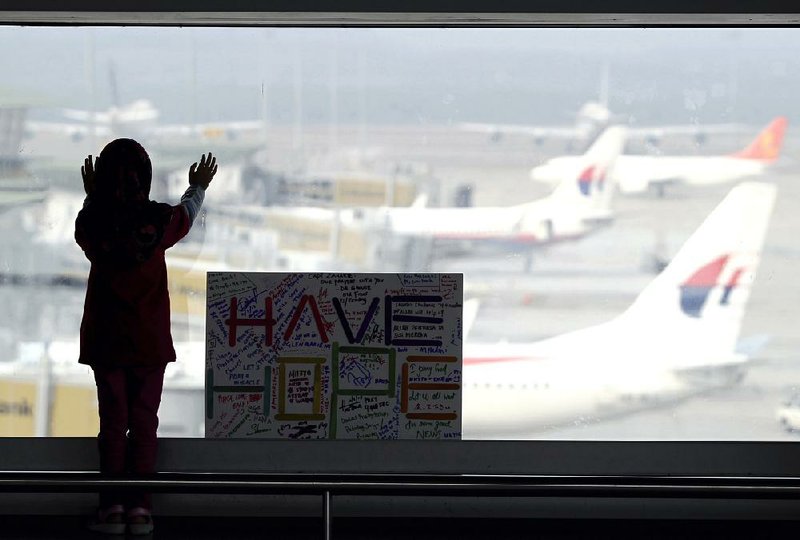MELBOURNE, Australia -- As Australia prepares a year-long search for Malaysia Airlines' missing Flight 370 in an area of ocean floor the size of Croatia or West Virginia, a government report underscores the lingering uncertainty about where the plane went, noting that it might have fallen in an area of the southern Indian Ocean up to 19 times as large as the new search area.
Warren Truss, Australia's deputy prime minister, announced plans Thursday for an exhaustive search of the areas of seafloor with the highest probability of holding debris from the Boeing 777-200, which vanished March 8 with 239 people aboard. That search is to cover an area totaling 23,000 square miles.
"The search area has at all times been based on the best information," Truss said at a news conference in Canberra, heading off questions about why the search area keeps moving.
But a detailed report issued Thursday by the Australian Transport Safety Bureau, the government agency overseeing the search, makes it clear that the plane's possible crash sites could lie far beyond the new search area.
The new search zone is based on five separate analyses of a series of seven electronic "handshakes" between the aircraft -- which disappeared after leaving Kuala Lumpur, Malaysia, for Beijing -- and a satellite over the equator. The five analyses were performed by experts at Boeing, the British satellite company Inmarsat, the French electronics group Thales, the U.S. National Transportation Safety Board and the Defense Science and Technology Organization of Australia.
The search zone encompasses the most probable locations calculated by each of the five teams. But each team also calculated a margin of error around its likeliest location. The new search zone encompasses this margin of error for some of the teams but not all of them.
It would take an area four times the size of the currently planned search to encompass the margins of error for all five teams, according to the safety bureau's report.
Because the teams used different methodologies, it is not possible to calculate the likelihood that the aircraft is within the narrower zone that is to be searched in the coming year, Martin Dolan, the chief commissioner of the safety bureau, said while changing planes at the Melbourne airport Friday afternoon.
"Limiting to 60,000 square kilometers in essence is, I wouldn't say arbitrary, but we wanted to put some provisional limits on the search," he said.
No decision will be made on whether to search the larger area until after the initial zone has been thoroughly examined in the coming year, a task for which the government has allocated $56 million.
The five official analyses also came up with an area of all possible locations for the missing plane, based on the satellite data. It spans an area of the southern Indian Ocean nearly 19 times the size of the zone to be searched in the coming year, according to the report by the safety bureau.
The wider area, known as the gray zone, includes not only where the plane might have wound up if it were going a little faster or slower than expected but also accounts for the possibility that a conscious pilot might have been at the controls and tried to glide the plane for as much as 100 nautical miles after it apparently ran out of fuel at the time of the last electronic handshake.
"The only thing we can absolutely guarantee is the aircraft is in the gray zone," Dolan said.
The safety bureau concluded in its report that the most likely scenario was that the aircraft headed south for five hours on autopilot during an "unresponsive crew/hypoxia event." Hypoxia occurs when a plane loses air pressure and the pilots and others aboard, lacking adequate oxygen, become confused and incapable of performing even basic manual tasks, even while continuing to feel considerable confidence in their own abilities.
Dolan said Friday that it was wrong to assume that this phrase meant only that the crew could have been unresponsive because of hypoxia. He said that it referred to crew "incapacitation or hypoxia."
Asked whether the crew could have been incapacitated by violence, Dolan said that was among the possibilities. But he declined to list the possibilities or speculate on their likelihood.
The investigation into why the plane went astray is under Malaysia's authority, he noted, while Australia is only trying to assess the aircraft's track so as to help find it.
In a further complication, the safety bureau also released a map of possible locations for the origin of an underwater sound in the Indian Ocean that appears to have occurred at the same time the aircraft is believed to have run out of fuel and crashed. That sound was detected by two listening devices located 220 miles apart on the southwest coast of Australia.
The map is a polygon that is 3,600 miles in length and extends northeast from a point in the south-central Indian Ocean all the way to the coast of Yemen. The polygon is only 68 miles in width at its widest point, and it passes between the Maldives, an island chain off the southwest coast of India, and Diego Garcia, a British island with a U.S. air base.
But the Australian Transport Safety Bureau said the locations in the polygon were incompatible with the satellite handshakes, for which the aircraft's angle to the satellite can be precisely calculated. Similar undersea sounds are also produced quite often by minor undersea earthquakes too small to register on seismographs.
A Section on 06/28/2014

